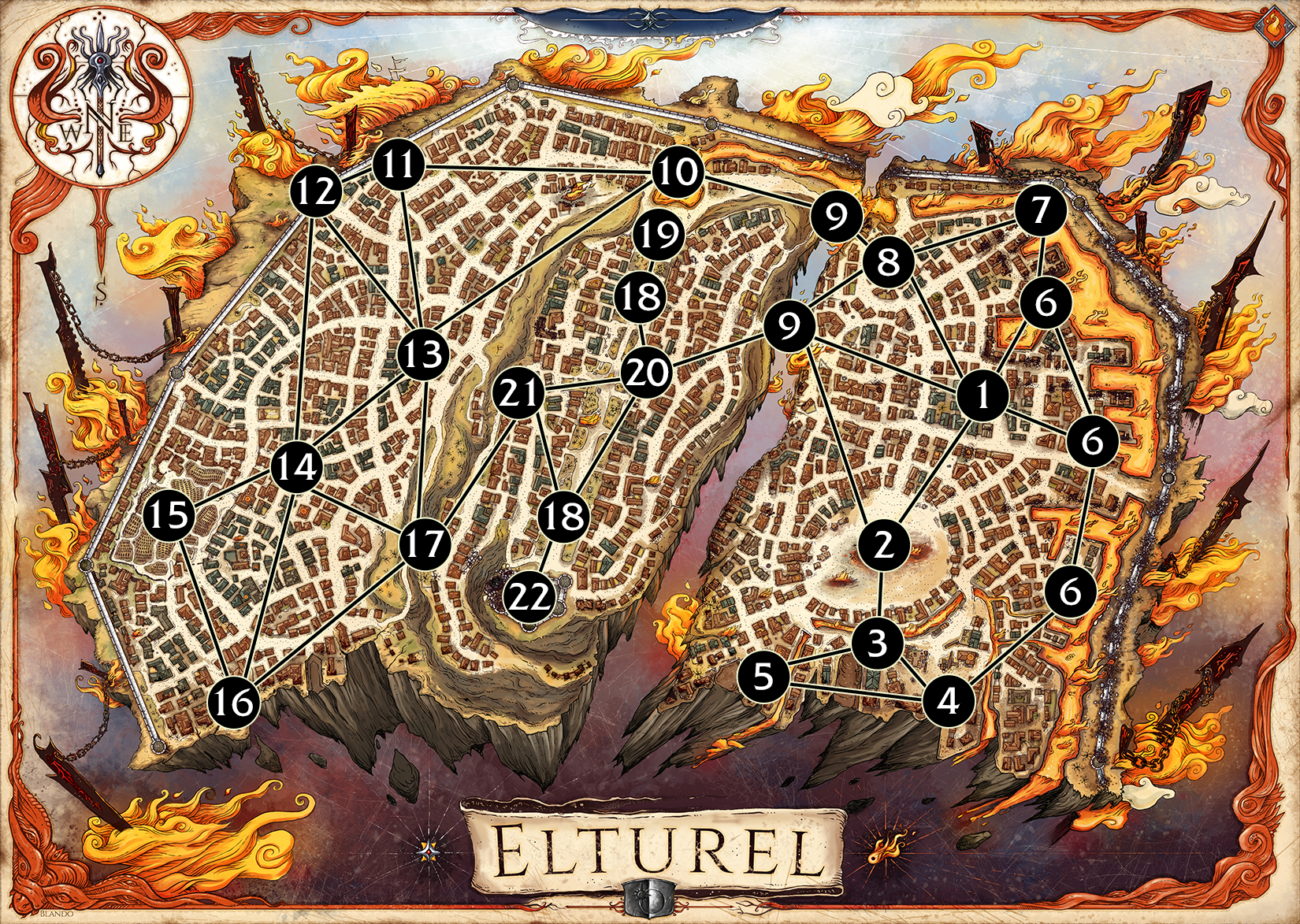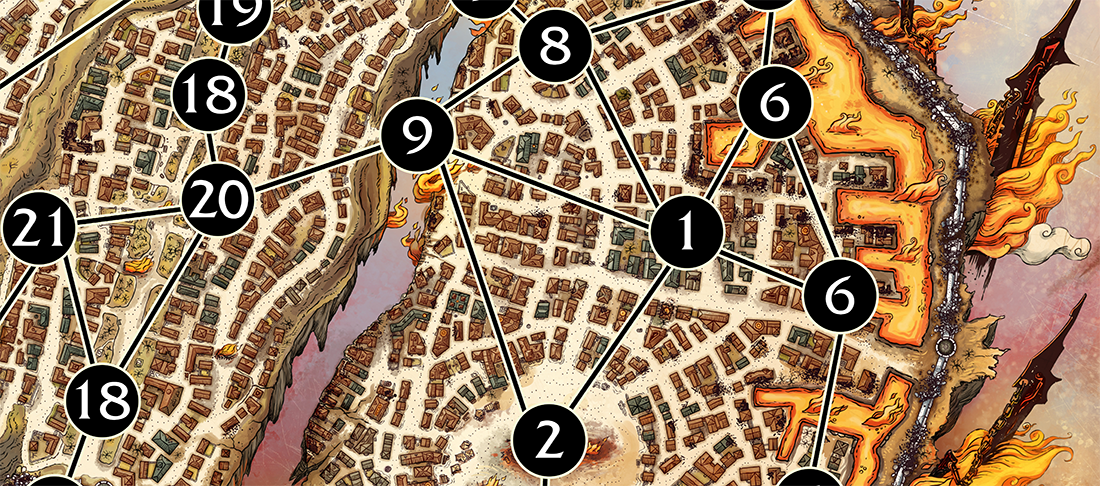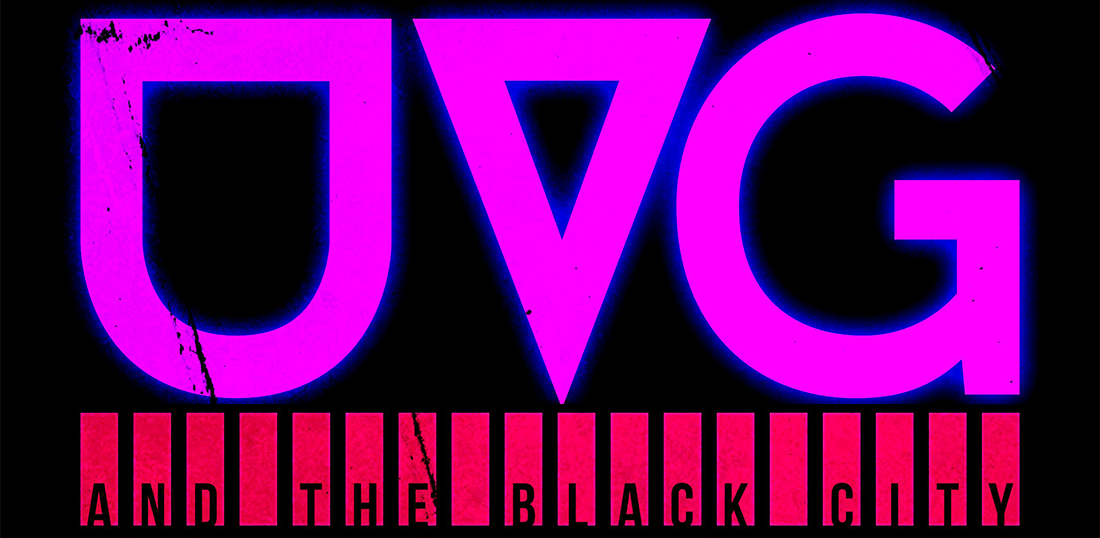Now that the PCs have gotten their bearings and received the map of fallen Elturel, we’ll switch from streetcrawling (as described in Part 5B) and begin navigating the city using a pointcrawl structure.
Pointcrawls are fairly straightforward. You can see how the point-map above has a number of keyed locations (points), connected in a node-map. PCs at one of the points can travel to any connected point.
The most literal application of a pointcrawl system is to model wilderness travel along a trail system (i.e., the connections between points are literally wilderness trails running between those locations). You might find similar utility if you were running a Neverwhere-style adventure set amidst a fantastical subway system. In either case, the pointcrawl is a player-known structure. Trivially so, in fact, because the point-map has a one-to-one correspondence with the game world: The characters can see the wilderness trails or subway tunnel that they’re following.
In the city, however, the pointcrawl system is an abstraction. It attempts to capture conceptual navigation – the way we think about traveling through a city – in a way that’s useful for the GM prepping and running the material. I believe that it can best succeed at this as a player-unknown structure. In other words, the point-map above is NOT the map of Elturel seen by the players: They interact with the city naturalistically; they don’t see the points and may not even know that a pointcrawl structure is being used.
So how does that work?
When the players indicate a navigational intention, the GM basically acts as an “interpreter” who translates that intention into the pointcrawl system, uses the pointcrawl system to resolve it, and then describes the outcome to them in terms of the fiction.
This works because we naturally think of navigating a city in broad terms. “We need to head west to Lyndale Avenue and then take that south into Edina.” What was the exact route we took west to Lyndale? Did we take 36th or 38th or 42nd or 46th? We don’t really care. (And, if we did, we’d probably still be using the streetcrawl system, right?) Particularly in a pre-GPS era, navigation was even more likely to funnel into landmarks and major thoroughfares: Cross the river at such-and-such a bridge, head east to the cathedral, and then cut south through Littlehut… and so forth.
The points of the pointcrawl match the mental model we use to navigate through a city.
If you’re still struggling to grok this, you can see the effect perhaps most clearly in Elturel at Torm’s Bridges. Here the conceptual and literal geographical navigation of the city are basically unified; the funnel effect is as literal as possible: If you want to cross the gorge between the western and eastern halves of the city, you’re going to pass through the bridges.
This conceptually remains true even when the literal geographical funnel is not so precise: If the PCs decide to head south from their arrival point to the Docks, they’re going to pass through Shiarra’s Market. Yes, it’s technically possible to take a different route that avoids the market, but in the absence of intentionality the point-map represents the general “flow” of the city.
(And in the case of intentionality, check out “Shortcuts & Side Routes,” below.)
Things you’re likely to say while running an urban pointcrawl:
- “Crossing Waterloo Bridge, you head south past the London Eye to Lambeth Palace.” (The PCs are leaving a vampire den somewhere near Covent Garden. Waterloo Bridge, the London Eye, and Lambeth Palace are all points on the point-map.)
- “You leave Delver’s Square and head up towards Oldtown. You pass Emerald Hill on your right, and you see the dawn hawks circling above it. Then you climb the ramp up into Oldtown and head down to the Administration Building.” (Delver’s Square, Emerald Hill, the Oldtown ramp, and the Administration building are all points. Oldtown is a neighborhood that contains many points.)
- “You leave Trollskull Alley, head south through the City of the Dead, and enter the Trade Ward. You take Nephranter’s Street through the Court of the White Bull and then south to the Caravan Court.” (The PCs are very familiar with the city here, so the GM summarizes by neighborhood – City of the Dead, Trade District – until they’re close to the target. The Court of the White Bull and Caravan Court are the nodes here; Nephranter Street is simply a way of contextualizing the journey. The GM could just as easily say, “…and enter the Trade Ward near the Court of the White Bull, taking Salabar Street down to the Caravan Court.” or “…and enter the Trade Ward, passing through the Court of the White Bull and crossing through the bustling crowds of River Street before reaching Caravan Court.”)
In all of these examples we’re assuming that the PCs already have some familiarity (or perhaps a great deal of familiarity) with the city. When they’re exploring a city for the first time – particularly a hazardous city filled with dangers like hell-bound Elturel – you’ll want to devote more attention to (and most likely have the PCs meaningfully interact with) each point as they encounter it for the first time.
BASIC POINTCRAWL PROCEDURES
The basic procedures for a pointcrawl are very simple.
STEP 1 – MOVE TO POINT: Assume moving to another point takes 10-15 minutes.
Design Note: Obviously you’d want to vary this for pointcrawls at different scales. You can also have connections of different lengths, indicating the travel time along a particular route by writing a small number next to the route, but this is probably overkill for Elturel.
STEP 2 – RANDOM ENCOUNTER: Check for a random encounter (see below).
Design Note: I recommend using a fairly high probability, much like the encounter checks for a streetcrawl described in Part 5B. Descent Into Avernus recommends a 1 in 2 chance of an encounter and that’s probably pretty solid.
If you were using a pointcrawl system in a less adventuresome city and/or one that the PCs have become more familiar with, you can step down either the frequency or intensity of encounters. (Encounters in a typical city can often just be a bit of local street color; they don’t always have to be meaty interactions. In this post I discuss how I would handle encounters in Waterdeep, triggering an encounter for whatever neighborhood the PCs were going to.)
STEP 3 – ARRIVAL: The PCs arrive at the next node.
If the PCs are in a point on the point-map, you can simply follow this procedure. If for some reason they’ve slipped “off” the point-map, simply funnel them logically into the point-map and continue from there. (You might be able to just assume they’re “at” the nearest point on the map; e.g., they may not be at the cathedral, but they’re close enough that they’re basically coming “from the cathedral” as far as other points are concerned. Alternatively, if you want to get all formal with it, you can think of their current location as a “temporary node” and think about how it would attach to the point-map.)
ADVANCED POINTCRAWL PROCEDURES
Here are a couple of advanced pointcrawl techniques that you may find useful in Elturel. (You can probably also ignore them entirely.) Their use may be more immediately obvious in player-known pointcrawls (where players can directly invoke them), but they can also be useful tools for GMs looking to interpret PC actions into a player-unknown pointcrawl.
SHORTCUTS & SIDE ROUTES: The PCs want to move from one point to another without moving through the points between. (For example, they want to go south to the Docks without passing through Shiarra’s Market.) What happens?
In some pointcrawls this might not be possible; in the wilderness it probably requires trailblazing. In a city, though, it usually just means getting off the major thoroughfares and circling around on side streets. In a safe city where time isn’t a factor, this probably just happens. Otherwise, use these guidelines:
Simple Side Routes:
- Determine an appropriate base time. (If they’re trying to go the long way around to bypass something, you can probably set this to whatever the travel time would have been going the normal way. If they’re trying to save time by using an unorthodox shortcut, eyeball the best case scenario.)
- Make a random encounter check.
- Make an appropriate skill check (probably Wisdom, possibly Wisdom (Stealth) if their goal is to avoid attention). Each check they make adds an extra chunk of time (probably 5 minutes in Elturel).
- If the check is a success, they arrive at their intended node.
- If the check is a failure, then they’re lost and will need to make another check. If they were trying to avoid trouble, the trouble finds them. Either way, they’ll need to repeat the random encounter check and the skill check until they succeed.
Detailed Side Routes: Alternatively, you can run this process using the streetcrawling rules. Their goal is charting out the alternate route, and this is probably a distant goal (requiring them to crawl through multiple chunks of the map).
This is probably overkill, and in a player-unknown pointcrawl like Elturel it may be difficult to smoothly transition between the streetcrawl and pointcrawl structures. But this approach may prove useful in certain circumstances.
HIDDEN ROUTES: A hidden route in a pointcrawl is simply a connection between two points that is not immediately obvious; i.e., the PCs have to find the route before they can use it. In a wilderness it might be the illusory druid paths. In a city it might be linked teleportation circles or perhaps the sewers.
Hidden routes are often discovered as part of a scenario or while exploring a particular point (i.e., you’re poking around the crypts beneath the cathedral and discover a tunnel heading to the harbor). In some cases it might be as easy as making an Intelligence (Investigation) or Wisdom (Perception) check to find the route.
If the PCs go looking for hidden routes in Elturel, I recommend pointing them in the direction of the Maze — the subterranean tunnels and storehouses that lie beneath the streets. Although it’s possible to include hidden routes on a point-map (I recommend a dotted line), in this case you can probably just improvise if it comes up in play.














